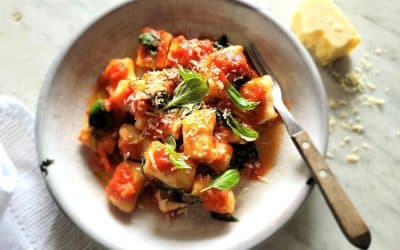Ratatouille is a classic French Provençal vegetable stew originating from the region of Nice in Southern France. It’s known for its vibrant colors, rich flavors, and versatility. While there’s a traditional preparation, there are also variations that adapt the dish to different tastes and preferences. Here, I’ll describe the traditional version and some popular variations:
Traditional Ratatouille Traditionally, ratatouille is a simple and rustic dish made with seasonal vegetables. Here’s a popular way on how it’s prepared:
Ingredients
- Eggplant (aubergine)
- Zucchini (courgette)
- Bell peppers (red and green)
- Tomatoes
- Onion
- Garlic
- Olive oil
- Fresh herbs (thyme, rosemary, basil)
- Salt and pepper
Preparation
Slicing the Vegetables
- Start by preparing the vegetables. You can choose to peel or leave the skin on, depending on your preference.
- Slice the eggplant and zucchini into rounds or strips, roughly of the same thickness.
- Cut the bell peppers into strips or squares.
- Dice the tomatoes.
- Finely chop the onion and garlic.
- Gather your fresh herbs, such as thyme, rosemary, and basil, and set them aside.
Sautéing
- In a large, heavy-bottomed pot or a deep skillet, heat olive oil over medium heat.
- Add the chopped onions and garlic and sauté until they become translucent, releasing their fragrance.
Layering the Vegetables
- Layer the sliced vegetables in the pot, alternating between eggplant, zucchini, and bell peppers.
- Season each layer with salt, pepper, and a sprinkle of fresh herbs. This helps infuse flavor into each layer.
Adding Tomatoes and Herbs
- Once all the vegetables are layered, add the diced tomatoes on top.
- Sprinkle with more fresh herbs, like thyme, rosemary, and basil.
Simmering
- Cover the pot and reduce the heat to low. Allow the vegetables to simmer gently for about an hour or until they become tender. The longer cooking time allows the flavors to meld together.
Stirring (Optional)
- You can gently stir the ratatouille occasionally to ensure even cooking, but be careful not to break up the vegetables.
Adjusting Seasoning
- Taste the ratatouille and adjust the seasoning as needed. You can add more salt, pepper, or fresh herbs to achieve the desired taste.
Finishing Touches
- Ratatouille is traditionally finished with a drizzle of high-quality olive oil just before serving. This adds a luscious richness to the dish.
Serving
- Ratatouille can be served hot, warm, or at room temperature. It’s a versatile dish that can be enjoyed as a side dish, a main course, or even as a topping for pasta or bread.
Cookware
To prepare the classic French dish Ratatouille, you’ll need some basic cookware and utensils. Ratatouille is typically made in a single pot or skillet, making it a straightforward and rustic dish. These basic cookware items and utensils will help you prepare it with ease, whether you’re making it as a main course or a side dish.
Dutch Oven or Large Skillet
A Dutch oven or a large, deep skillet with a lid is ideal for cooking Ratatouille. These cookware options offer ample space for simmering the ingredients together and help distribute heat evenly. A cast-iron skillet works beautifully for this purpose.
Knife
A sharp chef’s knife is essential for slicing and chopping the vegetables into uniform pieces. Ratatouille typically features ingredients like eggplant, zucchini, bell peppers, and tomatoes.
Cutting Board
A sturdy cutting board provides a safe and stable surface for chopping the vegetables. Choose one large enough to accommodate all your ingredients.
Wooden Spoon or Silicone Spatula
A wooden spoon or a heat-resistant silicone spatula is used for stirring and sautéing the vegetables in the pot. Wooden spoons are traditional and work well with high heat.
Measuring Cups and Spoons
Accurate measuring cups and spoons are necessary for portioning out ingredients like olive oil, herbs, and spices.
Lid
If your Dutch oven or skillet doesn’t come with a matching lid, you’ll need a separate lid or a piece of aluminum foil to cover the pot while the Ratatouille simmers. This helps the vegetables soften and meld their flavors.
Salt and Pepper Shakers
Seasoning is crucial in Ratatouille, so having salt and pepper shakers on hand is important for adjusting the taste to your preference.
Oven Mitts or Pot Holders
When using a Dutch oven, it may go into the oven to finish cooking, so oven mitts or pot holders are necessary for handling the hot cookware.
Platter or Serving Dish
Once your Ratatouille is cooked to perfection, you’ll want to transfer it to a platter or serving dish for a beautiful presentation.
Optional Mandoline Slicer (for precise slicing)
If you want very uniform slices of vegetables for a polished Ratatouille presentation, a mandoline slicer can be helpful.
Ratatouille captures the essence of Mediterranean cuisine, with its emphasis on fresh, seasonal ingredients and aromatic herbs. It’s a delightful and healthy dish that showcases the natural flavors of vegetables in a harmonious blend of textures and tastes.
Popular Variations
Ratatouille Niçoise The traditional version, as described above, is known as Ratatouille Niçoise, hailing from Nice. It’s a rustic and hearty dish.
Confit Byaldi (Inspired by the Movie “Ratatouille”) This variation became popular after the release of the animated movie “Ratatouille.” It involves arranging thinly sliced and neatly layered vegetables in a baking dish, often using a tomato sauce base. The presentation is more refined, resembling the dish featured in the film.
Ratatouille with Herbes de Provence You can enhance the flavor of ratatouille by using the traditional Provençal herb blend called “Herbes de Provence,” which typically includes thyme, rosemary, marjoram, oregano, and sometimes lavender.
Ratatouille with Capers and Olives For a briny twist, add capers and black olives to the dish. They complement the flavors of the vegetables and add a delightful Mediterranean touch.
Ratatouille with Chickpeas To make the dish heartier and more protein-rich, consider adding chickpeas. They absorb the flavors of the vegetables and the herb-infused tomato sauce.
Ratatouille Pizza Transform ratatouille into a pizza topping. Spread a thin layer of tomato sauce on pizza dough, then layer the cooked ratatouille and sprinkle with cheese before baking.
Nutritional value
The nutritional content of ratatouille can vary based on the specific recipe, the portion size, the particular ingredients and their quantities. However, here’s a general breakdown for a typical serving size (around 250 grams or about a cup) of ratatouille.
Nutritional Value of Ratatouille (for a 250g serving)
- Calories – 80-120 kcal
- Protein – 2-4g
- Total Fat – 4-7g
- Saturated Fat – <1g
- Monounsaturated Fat – 2-4g
- Polyunsaturated Fat – <1g
- Carbohydrates – 10-15g
- Sugars – 5-8g
- Dietary Fiber – 3-5g
- Cholesterol – 0mg
- Sodium – 10-300mg (depends heavily on added salt and other seasonings)
- Potassium – 400-600mg
- Vitamin C – 40-70% of the Daily Value (DV)
- Vitamin A – 10-30% of DV
- Vitamin E – 5-10% of DV
- Folate – 10-20% of DV
- Iron – 4-8% of DV
Some notes about ratatouille
- Ratatouille is low in calories and saturated fat but is rich in dietary fiber.
- It provides a variety of vitamins and minerals due to the mix of vegetables, particularly vitamin C from tomatoes and bell peppers.
- You can adjust the nutritional content by the amount of oil or type of oil you use. Olive oil is commonly used, which provides monounsaturated fats, known for their heart health benefits.
- Sodium content can vary widely based on whether you add salt and/or other seasonings containing sodium.
Ratatouille is a nutrient-dense dish that can be a part of a balanced diet and offers a great way to incorporate multiple vegetables into a meal.
Conclusion
Ratatouille is a versatile dish that can be adapted to suit your preferences. Ratatouille is a simple and rustic dish made with seasonal vegetable. Whether enjoyed as a side dish, main course, or even as a pizza topping, it showcases the delicious flavors of seasonal vegetables and the aromatic herbs of Provence.
For more delicious French dishes please see below.










0 Comments